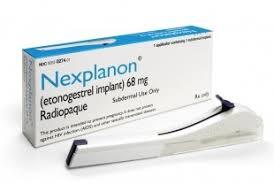Nexplanon Disease Interactions
There are 8 disease interactions with Nexplanon (etonogestrel).
- Abnormal genital bleeding
- Hepatic neoplasms
- Breast malignancy
- Liver disease
- Thromboembolism
- Depression
- Fluid retention
- Gallbladder disease
Contraceptives (applies to Nexplanon) abnormal genital bleeding
Major Potential Hazard, Moderate plausibility. Applicable conditions: Abnormal Uterine Bleeding
The use of contraceptives is contraindicated when there is an undiagnosed abnormal genital bleeding. Adequate diagnostic measures should be undertaken to rule out the presence of any malignancy.
Estrogens/progestogens (applies to Nexplanon) hepatic neoplasms
Major Potential Hazard, Moderate plausibility. Applicable conditions: Hepatic Tumor
The use of oral contraceptives is contraindicated in patients with liver tumors. An increased risk of benign hepatic adenomas and hepatocellular carcinomas has been associated with long-term, oral estrogen- progestin contraceptive use of at least 4 years and 8 years, respectively. Although these tumors are rare and have not been reported with other types of estrogen or progestogen therapies, any preparation containing estrogens and/or progestogens should probably be avoided in patients with existing tumors of the liver. Hepatic hemangiomas and nodular hyperplasia of the liver have been reported with isolated estrogen therapy.
Progestogens (applies to Nexplanon) breast malignancy
Major Potential Hazard, High plausibility. Applicable conditions: Breast Cancer
The use of progestogens is considered by manufacturers to be contraindicated in patients with existing or suspected malignancy of the breast. Some supportive data are available for medroxyprogesterone. Specifically, medroxyprogesterone treatment may be associated with breast cancer, primarily when the drug is administered intramuscularly. A pooled analysis of two case-control studies, one from the World Health Organization and the other from New Zealand, revealed a small overall relative risk of breast cancer in women who have ever used intramuscular medroxyprogesterone acetate. The relative risk was higher in the subgroup of women who had initiated therapy within the previous 5 years. Thus, an increased risk (approximately 2-fold) is associated with intramuscular medroxyprogesterone use in the first 5 years. A more recent U.S. study also found a statistically significant increase in breast cancer risk among recent users (defined as last use within the past five years) who used depo-medroxyprogesterone acetate for 12 months or longer.
Progestogens (applies to Nexplanon) liver disease
Major Potential Hazard, Moderate plausibility.
The use of progestogens, in general, is contraindicated in patients with impaired hepatic function or liver disease. There are little or no data concerning the pharmacokinetic disposition of the different progestogens in patients with hepatic disease. However, most hormones, including progestational hormones, are known to be extensively metabolized by the liver. Medroxyprogesterone should not be used by women with significant liver disease and should be discontinued if jaundice or disturbances of liver function occur.
Progestogens (applies to Nexplanon) thromboembolism
Major Potential Hazard, Moderate plausibility. Applicable conditions: Cerebral Vascular Disorder, Thrombotic/Thromboembolic Disorder, History - Thrombotic/Thromboembolic Disorder
The use of progestogens, in general, is considered by manufacturers to be contraindicated in patients with active thrombophlebitis, cerebrovascular disease, or a current or past history of thromboembolic disorders. While the role of progestogens in the development of thromboembolic events associated with hormonal therapy is often unclear and thought to be secondary to that of estrogens, it may not be insignificant. Medroxyprogesterone, a common progestational agent, has been shown to produce a hypercoagulable state in high dosages. Whether or not this effect contributes to the development of thrombotic events is unknown. However, thrombophlebitis and pulmonary embolism have been reported with megestrol, an antineoplastic and progestational agent. In addition, an increased risk of nonfatal venous thrombosis has been associated with oral contraceptive combinations containing desogestrel or gestodene relative to those that contain other progestins (e.g., levonorgestrel, norethindrone), suggesting some degree of hemostatic effect by progestogens.
Estrogens/progestogens (applies to Nexplanon) depression
Moderate Potential Hazard, Moderate plausibility.
The use of oral contraceptives has been associated with an increased incidence of depression. It is uncertain whether this effect is related to the estrogenic or the progestogenic component of the contraceptive, although excess progesterone activity is associated with depression. Patients with a history of depression receiving estrogen and/or progestogen therapy should be followed closely. The manufacturer of medroxyprogesterone recommends monitoring patients who have a history of depression and to not re- administer medroxyprogesterone if depression recurs.
Estrogens/progestogens (applies to Nexplanon) fluid retention
Moderate Potential Hazard, Moderate plausibility. Applicable conditions: Congestive Heart Failure, Migraine, Asthma, Seizures, Renal Dysfunction, Hypertension
Estrogens and progestogens may cause fluid retention, particularly when given in high dosages or for prolonged periods. Therapy with these agents should be administered cautiously in patients who have preexisting problems with excess fluid. In addition, patients with conditions that may be adversely affected by fluid accumulation, such as asthma, epilepsy, migraine, and cardiovascular or renal dysfunction, should be observed for exacerbation of their condition during estrogen and/or progestogen therapy.
Etonogestrel (applies to Nexplanon) gallbladder disease
Moderate Potential Hazard, Moderate plausibility.
Etonogestrel might increase the risk of gallbladder disease. Caution and monitoring of symptoms is suggested in patients with history or active gallbladder disease.
Switch to professional interaction data
Nexplanon drug interactions
There are 254 drug interactions with Nexplanon (etonogestrel).
Nexplanon alcohol/food interactions
There are 2 alcohol/food interactions with Nexplanon (etonogestrel).
More about Nexplanon (etonogestrel)
- Nexplanon consumer information
- Check interactions
- Compare alternatives
- Pricing & coupons
- Reviews (4,874)
- Drug images
- Side effects
- Dosage information
- During pregnancy
- Support group
- Drug class: contraceptives
- Breastfeeding
- En español
Related treatment guides
Drug Interaction Classification
| Highly clinically significant. Avoid combinations; the risk of the interaction outweighs the benefit. | |
| Moderately clinically significant. Usually avoid combinations; use it only under special circumstances. | |
| Minimally clinically significant. Minimize risk; assess risk and consider an alternative drug, take steps to circumvent the interaction risk and/or institute a monitoring plan. | |
| No interaction information available. |
See also:
Further information
Always consult your healthcare provider to ensure the information displayed on this page applies to your personal circumstances.


